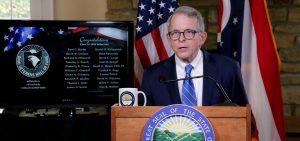News
Gov. DeWine Downplays Threat Of Another Shutdown Amid COVID-19 Resurgence
By: Gabe Rosenberg | WOSU
Posted on:
COLUMBUS, Ohio (Statehouse News Bureau) — Gov. Mike DeWine on Tuesday dismissed the idea of another statewide shutdown, even as Ohio sees its highest-ever surge of coronavirus cases – surpassing even the peaks of this spring and summer.

“The red tide of the virus continues to spread throughout Ohio into every corner of the state,” DeWine said.
While DeWine said he’s not taking anything off the table, the governor said he doesn’t support a second shutdown of non-essential businesses at this point.
“Here’s the difference: We already did that once. And we saved a lot of lives,” DeWine said. “And Ohioans should be very proud of where they are, or what they’ve done in the past. Twice they’ve been able to knock this virus down. But we know that a complete shutdown will have other consequences that are not good.”
“The spread isn’t coming from businesses,” added Lt. Gov. Jon Husted. “It’s coming from what people are doing in their own personal time.”
Instead, the culprits behind Ohio’s recent surge are mostly the kinds of large events DeWine has repeatedly warned about: large wedding receptions, crowded bars, house parties and extended family gatherings, all lacking face masks and social distancing.
One new area of concern is the game day watch party, which have emerged as the football season resumes at both the professional and college levels – including Ohio State University, which held its long-awaited first match of the season on Saturday. DeWine said people should enjoy the games but make sure they’re not spreading the virus at the same time.
“The community spread endangers our schools, our nursing homes, and our hospitals,” DeWine said. In some parts of the state, including Columbus and Cincinnati, the recent increase in cases has forced school districts to suspend in-person classes or delay their plans for hybrid learning.
The approaching winter weather and decreasing daylight have officials concerned about people being forced to stay indoors, as well as the likelihood of family gatherings and parties around Halloween, Thanksgiving and Christmas.
“Please reconsider hosting or attending gatherings of any size,” DeWine urged. “This includes with friends and extended family, people who don’t live in your household. Two, think about canceling events. Certainly, don’t go to Halloween parties. Three, wear mask inside and outside when you cannot social distance. Above the nose, over the mouth, secure over the chin.”
The Department of Health on Tuesday reported an increase of 2,509 new COVID-19 cases and 22 more deaths in the last day, along with 198 more hospitalizations and 20 more ICU admissions.
Last week, the state broke records for most daily new COVID-19 cases on four consecutive days, and on Monday surpassed the dreary milestone of 200,000 total cases.
To look at the surge another way: Ohio has reported above 2,000 daily coronavirus cases – a benchmark it hadn’t reached until this month – almost half of the days in October.
“It was not that long ago when this number, as you may recall three weeks ago, three and a half weeks ago, was hovering around 1,000 and we thought it was going to stabilize and stay below 1,000,” DeWine said.
The disease continues to spread most rapidly in more rural counties, with Putnam, Auglaize, Mercer, Holmes, Allen, Crawford, Monroe, Henry, Noble, and Van Wert counties leading the list of highest COVID-19 rates per capita.
Hospitalizations and ICU admissions have also reached new heights, reviving concerns about capacity that had subsided for months. And the governor says those increases aren’t likely to reverse anytime soon.
“The current increase in utilization is noticeable sharper, steeper, than the curve we saw in the spring,” DeWine said. “We’ve no indication that we’ve plateaued out at all.”
Despite economic struggles across the country and still-high unemployment, the White House and Congress failed to reach any deal over more coronavirus relief funds before the election – quashing hopes for resuming additional unemployment benefits or the payroll protection program for businesses.
Last Friday, DeWine and Republican leaders reached a deal to distribute $419 million in federal aid allocated by the CARES Act this past spring. Of those funds, which were approved by the Ohio Controlling Board on Monday, $125 million will go to small businesses of no more than 25 employees, $62 million will go to hospitals, $37.5 million will be dedicated for bars and restaurants, and $45 million is for nonprofits and arts groups.
Also included in the funding is $100 million for higher education and $50 million for rental, mortgage, water and sewer utility assistance.
“It will do a lot of good,” DeWine said.

